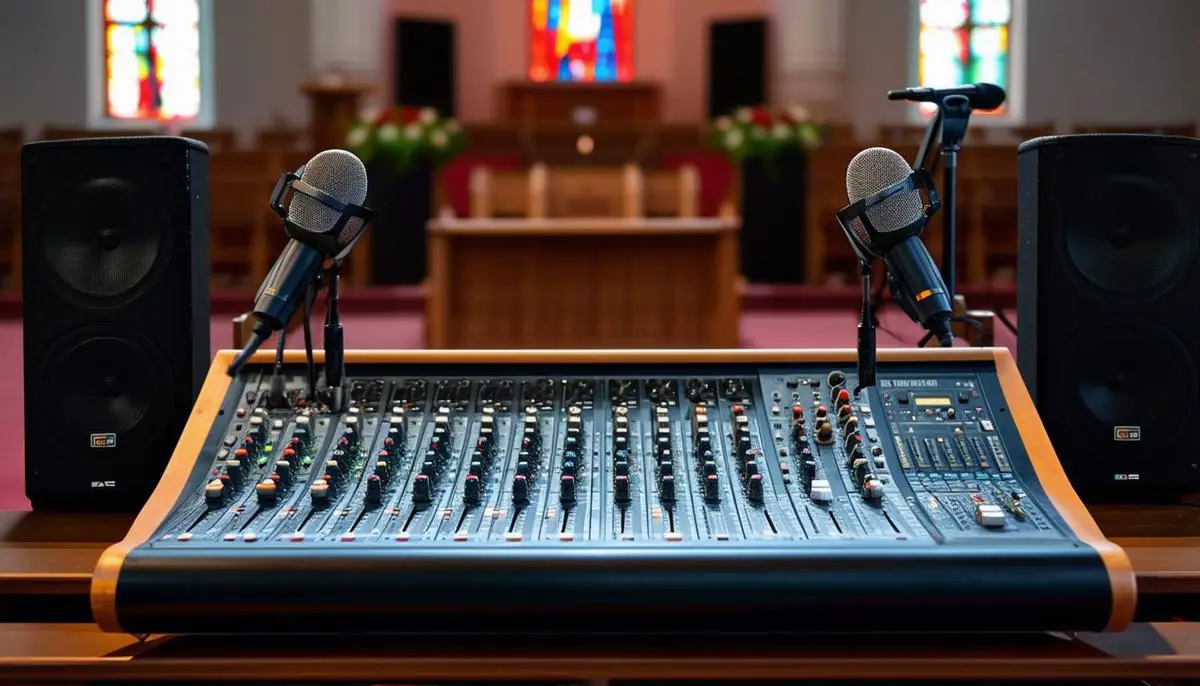Church Sound System Training
Sound Basics & Equipment Familiarization
Understanding the frequency spectrum is crucial for sound engineers. Voices and musical instruments have distinct sound signatures that peak around different frequencies. Recognizing these patterns allows engineers to accentuate or diminish certain audio aspects, forming the foundation of audio mixing.
Sound equipment identification introduces operators to essential components for a basic setup, including mixers, microphones, amplifiers, and speakers. Microphones, the initial point of capture, come in dynamic, condenser, and ribbon types, each with unique traits. Dynamic microphones, resilient to moisture and temperature variations, often capture louder sources like drums and electric guitars.
Speakers, the endpoint of the sound path, vary in type and placement based on the church’s acoustic properties. Full-range speakers, subwoofers, monitor speakers, and bass speakers each affect auditory results significantly.
Mixers control and combine audio channels, with features like routing, signal flow, EQ settings, and effects. Amplifiers bolster sound signals from the mixer to levels audible through speakers, with solid state, tube, and hybrid types available.
Optimizing settings on each component is key to achieving near-perfect acoustic output and enhancing the sanctity of church ceremonies. Understanding these fundamentals equips church sound system operators with the necessary knowledge for effective audio amplification.

Microphone & Loudspeaker Handling
Microphone and loudspeaker handling involves mastering how and where to use these tools to maximize sound quality. Microphones differ in their polar patterns, which determine how they pick up sound. Cardioid microphones, commonly used in churches, capture sound mainly from the front and are less sensitive to the sides and rear, reducing feedback when close to loudspeakers.
Loudspeakers also vary in design and purpose. Point source speakers spread sound from a single point, while line arrays project sound more consistently over longer distances. Line arrays are beneficial in larger church interiors for maintaining sound clarity without excessive volume near the front.
When installing loudspeakers, understanding the coverage area and positioning is essential. Even coverage throughout the church is crucial, avoiding areas of overlap that can create muddy or unclear audio zones. Subtle angling adjustments can optimize sound distribution, enhancing clarity and minimizing phase cancellations.
By pairing microphones with appropriate sources and strategically placing loudspeakers, church audio technicians can foster a soundscape where every note and word is clearly heard, enriching the spiritual experience.

Mixing Techniques & Audio Trouble-shooting
Understanding the audio console and its controls is essential for church audio operators. Gain control, the initial step in mixing, adjusts the input level of sound sources. Proper gain setting prevents clipping and noise, creating a stable foundation for further enhancements.
Equalization (EQ) involves adjusting the balance of frequencies in an audio signal, shaping each element’s tone within a mix. Cutting or boosting specific frequency ranges can improve intelligibility and presence, adapting the sound to the church’s acoustics and the service’s aesthetics.
Effects like reverb and delay add depth and space to the sound, enhancing worship music or adding a ruminative quality to prayers and readings. Dynamics control, such as compression, helps maintain consistent volume levels, preventing parts from being too loud or soft.
Auxiliary sends (Aux Sends) allow the creation of multiple mixes from the same inputs, useful for differentiating the house mix from monitor mixes or sending signals to other rooms.

Anticipating and addressing common sound problems, such as feedback, is crucial. Understanding microphone placements, speaker positioning, and using EQ to notch out problem frequencies helps troubleshoot issues. Sound checks before services can identify potential feedback frequencies and allow for system adjustments.
- Identify the feedback frequency: Listen carefully to determine the specific frequency causing the feedback.
- Adjust the EQ: Use a graphic or parametric equalizer to reduce the gain at the feedback frequency.
- Adjust microphone placement: Move the microphone away from the speakers or alter its angle to minimize direct sound entering the microphone.
- Adjust speaker placement: Reposition the speakers to reduce direct sound entering the microphones.
- Use a feedback suppressor: Employ a dedicated feedback suppression device or software to automatically detect and eliminate feedback frequencies.
Practice and attentiveness play invaluable roles in adopting these mixing principles. Each church’s acoustics and preferences may differ, requiring slight adjustments and continual optimization to produce the best possible sound.
- Davis G, Jones R. The Sound Reinforcement Handbook. 2nd ed. Milwaukee, WI: Hal Leonard Corporation; 1990.
- Ballou GM. Handbook for Sound Engineers. 4th ed. Burlington, MA: Focal Press; 2008.
- Eargle J. The Microphone Book. 2nd ed. Burlington, MA: Focal Press; 2004.













